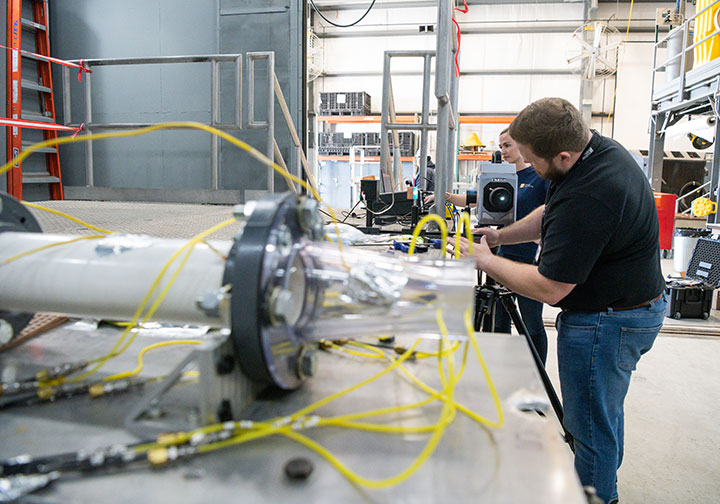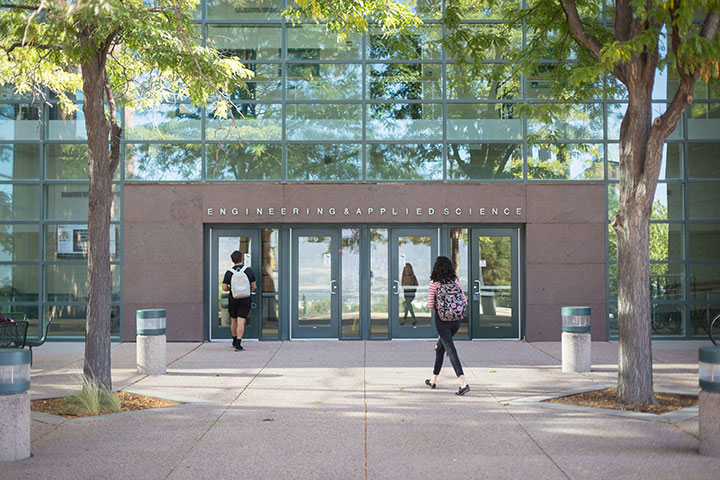ALEXANDRIA, Va. — How do you win the next space technology race? By getting an early start. As Space Force matures, it’s investing in academic partnerships to prepare the next generation of servicemembers and space professionals to address the technology challenges just over the horizon.
 A propulsion research team with the University of Tennessee Space Institute set up an experiment at Arnold Air Force Base, April 22, 2022. (Source: U.S. Air Force/Jill Pickett)
A propulsion research team with the University of Tennessee Space Institute set up an experiment at Arnold Air Force Base, April 22, 2022. (Source: U.S. Air Force/Jill Pickett)
After an initial series of pilot projects in partnership with the Air Force Research Lab (AFRL), the Space Force is launching a series of research opportunities through the University Consortium (UC), a funded initiative that encourages universities to work together with government and industry to tackle some of the biggest challenges in space.
“Even with superlative talent and exceptional capabilities, Space Force will not succeed without a robust joint coalition, international, academic and commercial partnerships, which is…what the Space Force University Consortium is all about,” said Nick Kamin, the technical director of the U.S. Space Force Science Technology and Research Directorate and UC lead.
One of the essential goals of the UC is to transition applied research into prototypes of advanced capabilities. The program brings together several institutions under a single lead to address mutual areas of interest that will help maintain a technological edge in space.
“It takes a number of universities to come together with industry and government in order to advance research to develop technologies,” Kamin emphasized. He added that the paradigm of industry and academic partnerships for transitioning applied research is the University Consortium’s “starting point…to advance technology development, prototyping and demonstration in a faster, more effective manner.”
Currently, the UC is focused on five areas of innovation, where it plans to award research funding. These Strategic Technology Institutes include:
- Beyond geostationary Earth orbit (xGEO) operations and space domain awareness (SDA)
- Dynamic space operation—including in-space servicing, assembly and manufacturing
- Advanced power and propulsion
- Advanced remote sensing technologies and operating concepts
- Cyber mission assurance and data trust
“These topics are directly related to space and science technology challenges,” Kamin told Constellations. “Which really means, in the year 2032, what are some of the capabilities we will need to have to prepare ourselves for technology surprises and remain a leading nation in space?”
Moving Forward with Funding
The University Consortium is currently being supported by a roughly $30 million congressional add in the FY 2023 budget. That and related funding is enabling Space Force to develop relationships within academia comparable to other service branches. A portion of the budget will go toward the multi-year cooperative UC research agreements awarded to universities in each of the five strategic technology areas. Space Force is requesting continued funding for the UC and other areas of academic partnership in future years. It also sees a role for commercial funding to support technology transitions.
In March, the Space Force formally announced its first UC research opportunity for xGEO space domain awareness (SDA) capabilities. The request for proposal covered cislunar operational technologies, SDA data utilization tools, advanced sensing, visualization concepts and more. The winners of the award will be announced soon.
Space Force plans to release two additional opportunities for awards in the coming month covering the remaining research areas. An earlier research opportunity awarded in 2022 served as a pilot for current efforts.
The sequence of announcements has been prioritized “based on the demand signal by the Space Force,” Kamin explained. The research areas themselves are the result of feedback from various university participants who have been in discussions with the service for several years.
In 2021, the Space Force stood up a University Partnership Program (UPP) as an early effort to build a channel for recruitment, workforce development, education and research opportunities. It has since grown to over a dozen schools. Participating universities include Arizona State University, Clemson University, George Institute of Technology, Howard University, North Carolina Agricultural and Technical State University, University Massachusetts Institute of Technology, Purdue University, The University of Southern California, The University of Texas at Austin and El Paso, University of Colorado at Boulder and Colorado Springs and the University of Puerto Rico.
 The College of Engineering and Applied Sciences at the University of Colorado, Colorado Springs. (Source: UCCS)
The College of Engineering and Applied Sciences at the University of Colorado, Colorado Springs. (Source: UCCS)
The University of Colorado at Colorado Springs was one of the earliest members of the UPP and has been engaged in ongoing discussions with Space Force about research opportunities and space workforce development strategies. Until recently, the lack of funding and the newness of the force were obstacles to university initiatives getting off the ground.
“We’re starting to see a bit of progress now that they’re coming into a full budget cycle and they’re starting to get a better sense of what their needs are,” said Mike Corl, the associate dean of the UCCS College of Engineering and Applied Science. “It looks like things are on the verge of happening, and that’s a good sign.”
In addition to releasing new research opportunities, Space Force also plans to host its second University Consortium Symposium this summer. Last August, representatives from 26 universities and industry participants met with USSF principals to explore areas where university research efforts overlap with Space Force science and technology priorities.
According to Kamin, this year’s symposium will focus on research in cyber mission assurance and data trust. “Based on the information that we gather, it does help us put together the RFP, but really [builds] an awareness of the mutual areas of interest.” The date for the second symposium has not been announced.
All universities are encouraged to engage with the UC and Space Force, not just those that are UPP partners or have existing DoD relationships. As part of a broader effort toward inclusivity and diversity, Space Force plans to expand engagement with Historically Black Colleges and Universities (HBCUs) and minority-serving institutions.
These partnerships are “really a strong point” for the service, said Kamin, adding that the force is “actively seeking collaboration and recruits from underrepresented communities.” Space Force currently has formal partnerships with Howard University, North Carolina A&T and the University of Puerto Rico at Mayagüez through the UPP.
Developing Tomorrow’s Space Workforce
In designing the University Consortium, there was an effort to avoid overly proscriptive research opportunities and areas of interest, according to Kamin. “They’re very broad because we don’t want to limit the thought process, the ingenuity and out-of-the-box ideas that universities and industry have in coming up with capabilities we would need for Space Force and the space of the future.”
With an end strength of just 8,600, Space Force relies on academic, commercial and international partners as a force multiplier. Universities expand the service’s access to applied research and innovation and improve opportunities for prototyping novel technologies.
“The hope is that the academic world would be state of art and pushing the boundaries of what’s possible. And that’s what they’re looking for there,” said Corl.
The benefit to universities is not only research dollars. Through the UC, students and researchers can access supporting organizations, like NASA and DARPA, the network of national labs and multiple DoD service branches. Research opportunities also prepare young professionals to test technologies in a space or simulated environment, work with industry leaders, adapt feedback from operators and gain first-hand experience in readying technology for a national security customer.
“Space is a vast and growing industry where we foresee great demand for STEM professionals and other supporting professionals,” Kamin noted. “Participating in the Space Force University Consortium provides research institutions with research funds but also offers certain job opportunities and practical experience.”
Explore More:
Podcast: The AFRL Exchange Program, Aligning Military and Commercial Needs
University Spotlight: How an Experimental GPS Receiver is Changing Electronic Warfare
University Spotlight: A Systems Engineering Approach for Emerging Space Actors
University Spotlight: Enabling SmallSat Autonomy Through Onboard Fault Detection
